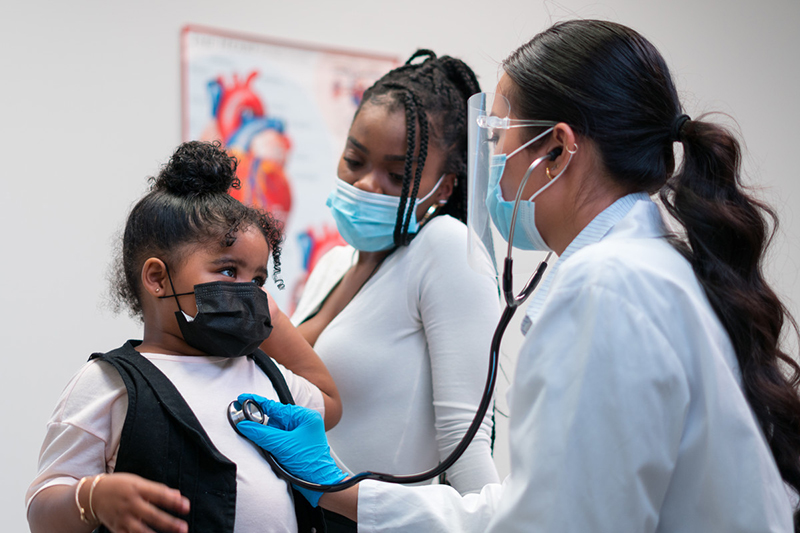
Around this time last year, NIH announced research funding to help identify children at risk for developing Multisystem Inflammatory Syndrome in Children, or MIS-C. Most children who develop MIS-C have unnoticeable or mild symptoms after a SARS-CoV-2 infection or exposure. Despite this seemingly benign origin, MIS-C is a severe, sometimes fatal, condition marked by inflammation of two or more organ systems. Researchers now know that the effects of MIS-C can linger for months, adding to the list of “long COVID” outcomes. Identifying who is at risk and developing ways to treat this condition are essential as the pandemic continues.
I’m pleased to share initial results from this NICHD-led initiative—Predicting Viral-Associated Inflammatory Disease Severity in Children with Laboratory Diagnostics and Artificial Intelligence, or PreVAIL kIds—as it reaches its one-year milestone. This initiative is also part of NIH’s CARING for Children with COVID and RADx® Radical research programs. The eight awardees have enrolled more than 4,500 prospective and 27,000 retrospective participants, including 700 with MIS-C, across the United States, Canada, United Kingdom, and South America. Several investigators are looking for biomarkers to help differentiate MIS-C from Kawasaki Disease, severe COVID-19, and other childhood illnesses.
One group, led by Usha Sethuraman, M.D., from Central Michigan University, presented its biomarker findings at the annual American Academy of Pediatrics conference in October. They reported that higher levels of the cytokine CXCL10, when measured in saliva, were associated with more severe forms of COVID-19 in children. They also identified several microRNAs, also from saliva samples, that correlate with severe infection in children. Further testing and validation of such biomarkers can help predict a child’s risk for complications and enable early monitoring and preventive treatment.
Another group, led by Jane C. Burns, M.D., and Ben A. Croker, Ph.D., of the University of California San Diego School of Medicine, offered key information about a common MIS-C treatment called intravenous immune globulin (IVIG). The team found that IVIG likely works by depleting immune cells called neutrophils. This important research, which was featured on the cover of the Journal of Clinical Investigation, promises to aid healthcare providers as they continue to identify and improve treatments for MIS-C.
NICHD also supports NIH’s Researching COVID to Enhance Recovery (RECOVER) Initiative , which launched in September to study the long-term effects of COVID-19 by following participants across the country. This diverse group of participants includes some of NICHD’s populations of interest—pregnant women and children. Pregnancy and pediatric COVID-related common data elements, which were developed by NICHD-led working groups, have also been shared with RECOVER investigators for potential inclusion in their work.
As part of RECOVER, we are evaluating potential long-term effects of COVID-19 in pregnancy by following people who had SARS-CoV-2 infection (asymptomatic or symptomatic) during their pregnancies. Researchers will also evaluate the infants who were exposed to SARS-CoV-2 in utero during the infection for neurologic symptoms and cardiovascular conditions as they grow older.
In addition, we’re supporting RECOVER’s Collaborative Long-term study of Outcomes of COVID-19 in Kids (CLOCK) consortium , a critical RECOVER partnership that includes several PreVAIL kIds investigators. The $30 million endeavor will study the long-term and delayed impacts of COVID-19 on children across the United States. The researchers seek to better understand long COVID, identify risk factors, develop treatments, and ultimately prevent the development of this serious condition.
Our institute is also investigating the Delta variant, which has caused more hospitalizations among infants and children. Currently, we do not know if the Delta variant is causing more severe disease in children, or if the higher rates of hospital admission are simply due to greater community transmission of the virus. One NICHD-funded project hopes to discern what is happening. The researchers, led by Tell Bennett, M.D., of the University of Colorado School of Medicine, have built a pediatric COVID-19 severity dashboard to track the impact of the SARS-CoV-2 pandemic on children. The dashboard, which provides new data on an approximately weekly basis, leverages electronic health records data from the National COVID Cohort Collaborative. It will also provide critical information if other variants, such as Omicron—first identified in the United States by one of our PreVAIL kIds investigators—become predominant.
Although we have made great strides in understanding the long-term effects of COVID-19, I want to reiterate the importance of vaccination as the best prevention. Pregnant women who are vaccinated pass protective antibodies to the developing fetus. Nursing mothers who are vaccinated also pass protective antibodies to their infants. Children ages 5 years and older are now eligible for vaccination. I encourage parents and guardians to vaccinate themselves and their children as the best way to optimize not only their health and safety, but also the health and safety of others during the pandemic. To find a vaccination location near you, visit https://www.vaccines.gov/search/.
 BACK TO TOP
BACK TO TOP